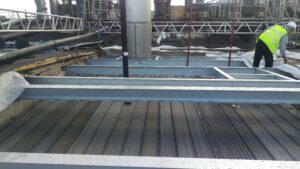Flat Roofing FAQs
 We love flat roofs! They look great, are cost-effective, and can be designed to fit buildings where traditional pitched roofs just aren’t possible. If they’re well looked after, flat roofs can also have a long and happy lifespan with minimal effort.
We love flat roofs! They look great, are cost-effective, and can be designed to fit buildings where traditional pitched roofs just aren’t possible. If they’re well looked after, flat roofs can also have a long and happy lifespan with minimal effort.
Unfortunately, thanks to the somewhat ugly (and leak-prone) flat roofs of yester-year, many people have quite negative associations when it comes to this style of roofing. Older flat roofing installation methods and materials left a lot to be desired. But thankfully modern flat roofs are different. Better quality materials and improved workmanship mean that the flat roofs of today are a great option for many situations.
On this page, we hope to answer the most common questions about flat roofs so you can understand why they might just be the solution you’re looking for.
What Are the Advantages of a Flat Roof?
There are many advantages to choosing a flat roof over a traditional pitched roof, though of course everyone’s reasons for choosing a flat roof will vary. Flat roofs are a great choice for both domestic and commercial settings that may have differing requirements from their rooftop. However generally speaking the advantages are the same, for example:
- Quicker to install: Flat roofs are much easier to install than a pitched roof and are therefore quicker too. Choosing a flat roof can cut down on build time if you’re putting a roof on a new building, plus it can reduce displacement costs (like renting alternate accommodation or storage) if you’re replacing an existing roof.
- Cost effective: Quick install, cheaper materials, and easier repairs mean that flat roofs are cheaper to both build and maintain than pitched roofs.
- Can provide extra living space: If you’re planning a flat roof for a domestic project, your flat roof could become useful extra living space, such as a roof deck and BBQ area or a relaxing oasis to sit and unwind. You may also be able to design your roof to become a stunning and eco-friendly green roof. A great way to add value and space if you’re apartment living, or your home is on a small plot of land.
- Can be added to easily: This is a consideration if you want to future-proof your home or commercial building. A flat roof is perfect for adding solar panels, air-conditioning, or heating units onto. The flat surface makes installation easy – which means it’s cheaper too!
- Can be used on interesting architectural designs: Flat roofs can look sleek, contemporary, and be made to fit different shapes and designs of roofs which tiled roofs just can’t, like the atrium roof of Birmingham New Street station – a memorable commercial project for the Sureseal team.
- Easy maintenance: Once the flat roof has been installed, maintenance is easy. A flat surface can be conveniently inspected without the need for scaffold or harnesses, as you would need on a pitched roof. Therefore it can be a DIY job, or a relatively low-cost job if you prefer to call in the professionals.
- Energy efficient: Flat roof systems are a sealed unit, so are much more energy efficient than a traditional tiled pitched roof. An insulated layer in a flat roof will help retain heat, reducing heating costs in the cooler months too.
Are Flat Roofs Cheaper than Pitched Roofs?
Yes. A flat roof is cheaper in many aspects when compared to a pitched roof. Installation is quicker and easier, therefore labour costs are reduced. The materials needed for a flat roof are cheaper than traditional pitched roof materials, so the cost of the roof itself plus any parts needed for future repairs will be lower in cost too.
While some flat roofs may need repair work if not looked after properly, generally speaking the task of maintenance and repairs are cheaper on a flat roof when compared to a traditional pitched roof, as access is easier and lower-risk.
Are There Different Types of Flat Roof?
There are various materials used for flat roofs, which may be recommended due to the size, design, or budget of your roof. Flat roofs can be built using:
- Felt
- Asphalt
- Ethylene Propylene Diene Monomer (EPDM) rubber
- Fibreglass
- Single-layer membrane
- Modified bitumen
- Built-up roofing.
Fibreglass is becoming a more popular choice, but each material has its pros and cons, so feel free to ask our team for more advice.
Are Flat Roofs Easy to Maintain?
‘Out of sight, out of mind’ is not the saying to follow when it comes to flat roofs! While homeowners with pitched roofs may pay little attention to them for years until a leak or problem occurs, flat roofs do require ongoing maintenance. This will ensure that they reach their full potential lifespan.
The good news is that while the idea of frequent maintenance may sound like an additional hassle, it’s actually pretty simple. If you don’t fancy getting up on a ladder though, our team is here for you offering professional flat roof inspections at your convenience.
An annual inspection to check for any issues like water pooling, mould, and rips or damage to the roof membrane can take care of any small issues before they turn into big and possibly costly problems. If you live in an area with turbulent weather – storms, snow, high winds, strong sun, or heavy rainfall – a bi-annual inspection is a good idea.
How Do Flat Roofs Drain Water?
 Despite their name, flat roofs aren’t completely flat. The minimum slope of a flat roof is 1cm of height across a 60cm span, so it looks flat to the naked eye but has a gradient designed to aid with water drainage. The slope of the roof directs water to a gutter on one or more sides, which can be incorporated into the roofing material for a seamless appearance.
Despite their name, flat roofs aren’t completely flat. The minimum slope of a flat roof is 1cm of height across a 60cm span, so it looks flat to the naked eye but has a gradient designed to aid with water drainage. The slope of the roof directs water to a gutter on one or more sides, which can be incorporated into the roofing material for a seamless appearance.
Keeping the roof and gutters clear of debris such as leaves, twigs and small branches is important to ensure good drainage, so you may need to consider any nearby vegetation to your roofscape at the planning stage. If you live in an area that experiences high volumes of rainfall, it’s a good idea to take that into consideration when designing your roof, as you may need a higher gradient of slope or more provisions to aid with drainage. You can read more about flat roof drainage on our blog.
How Long Do Flat Roofs Last?
Expertly installed modern flat roofs will have a life span of 20-50 years, depending on the material you choose. Adopting a comprehensive maintenance plan of inspections and cleaning will help to extend the life of your flat roof and can help to avoid the need for premature replacement or major repairs.
How Do I Know When my Flat Roof Needs Replacing?
Deciding to replace a roof is a big decision to make. Factors like how old the roof is and the condition of your flat roof will determine whether you can undergo repairs or if it’s better to opt for a full replacement.
The tell-tale signs that it might be time to replace a flat roof are if there is a significant pooling of water on the roof or visible signs of damage, such as ripped seams along the edges of the roofing material, blistering of the roof material, or water damage on the inside of your property due to a roof leak.
It goes without saying that the initial cost of a roof replacement will be higher than that of a roof repair. However, if your roof is in a poor condition, the ongoing cost of continual repairs it is likely to overtake the single outlay of a new roof.
How Do I Find the Right Contractor?
Sometimes, as with many aspects of building work, there are businesses out there looking to make a quick buck – that end up doing a bad job. Getting multiple quotes from different contractors is the best way to get a good idea of what materials and labour options are suggested for your project, and the associated costs. If you get a quote that is substantially lower than the others, it’s likely that the materials or workmanship will be low quality.
At Sureseal Flat Roofing, we have over 20 years of experience and a catalogue of completed projects and happy customers behind us. Quality, responsibility, honesty, and reliability are our core values, so you know you can trust us with your flat roof project.
We hope that by answering the most common questions about flat roofing, we can put your mind at ease and quell any concerns you may have had about installing a flat roof at your property. We welcome all enquiries, so if you have a question we haven’t answered here, our team are ready and happy to help. Contact Sureseal Flat Roofing today to discuss your project or to make a booking.
